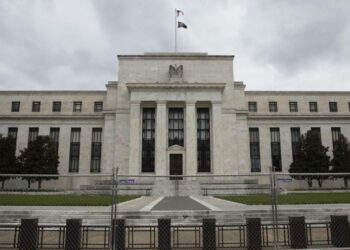When the world’s biggest and most liquid market shows signs of stress, investors should take note.
At the beginning of this month, major financial market participants trading in the US Treasury bond market had difficulty meeting the demands for collateral made by their counterparties.
The alarm bell was reported in the Federal Reserve Bank of New York’s Primary Dealer Statistics, in the weekly report for “fails” for US Treasury securities. A “fail” occurs when a market participant breaks a promise to receive or deliver securities when they are obliged to do so.
In the week ended April 6, there were a total of $507bn in fails reported by the primary dealers, a sharp rise from $358bn in the previous week ended March 30. The level fell back down again to $275bn in the subsequent week and was far below the $5.3tn peak of fails seen in one October week in the 2008 financial crisis. But the jump this month was notable — the highest level of fails since March 2020.
During that March, you will recall, financial markets very publicly ground to a halt due to Covid-19 lockdowns. This time, though, there was no particular, visible trigger event.
Even in the normal course of business, some securities transactions will fail. As the New York Fed has noted: “Fails occur for a variety of reasons. One source of fails is miscommunication. Despite their best efforts to agree on terms, a buyer and seller may not identify to their respective operations departments the same details for a given transaction.”
Or, as the New York Fed says, there can be “operational problems”, such as those arising after the September 11 2001 terrorist attacks. “Less extreme operational problems can also precipitate settlement fails, and are not uncommon,” it says.
But the fails reported this April go beyond a burnt out piece of equipment or a mumbled order or two. There are a number of disincentives for controlling the size and number of fails. After the massive settlement problems of the financial crisis, a charge on fails was introduced in May 2009 of up to 3 per cent of the trade value. The charge was extended from Treasuries to US agency debt and agency mortgage-backed securities in February 2012. That adds up when you are looking at tens or hundreds of billions of dollars.
Part of the dealers’ problem in early April was a recent significant cutback in the US Treasury’s issuance of short-term bills, particularly the four-week bills that are the most liquid form of collateral for other transactions. Those would include margin posts required by clearing houses for commodities or foreign exchange trades.
As the Treasury has been borrowing less to cover stimulus payments and extra pandemic-related costs, its debt managers have been rebalancing the profile of its securities issuance by selling fewer short-term bills. This is in line with “good practice”: the Treasury’s advisory committee has agreed that only 15 to 20 per cent of total issuance should be in the form of bills.
This prudent debt management, however, does not take into account the greater utility of Treasury bills as collateral because their prices are the least vulnerable in a rate-rising period.
Primary dealers can take advantage of their direct participation in Treasury auctions to obtain lots of bills. Then lesser market players, such as highly levered private equity funds, or the giant commodities trading houses, can rent the bills for a fee to be posted as margin with clearing houses against volatile energy, interest rate or foreign exchange contracts.
The primary dealers demand other collateral in return for lending the Treasury bills, most frequently in the form of lower-rated or less liquid securities such as corporate bonds. This process is known as “collateral transformation”, a way to turn chicken droppings into chicken salad, so to speak.
Unfortunately, sometime in the days leading up to April 6, a very large amount of the lower-rated collateral was apparently devalued, according to my market contacts. When that shock was combined with the tightness in the bill supply, you had a collateral squeeze.
As a 2017 New York Fed paper puts it: “Large and protracted settlement fails are believed to undermine the liquidity and well-functioning of the securities market.” As one bond market expert tells me, “This is not yet at the level of October 2008, when there were $5tn in fails. But something is broken.”










